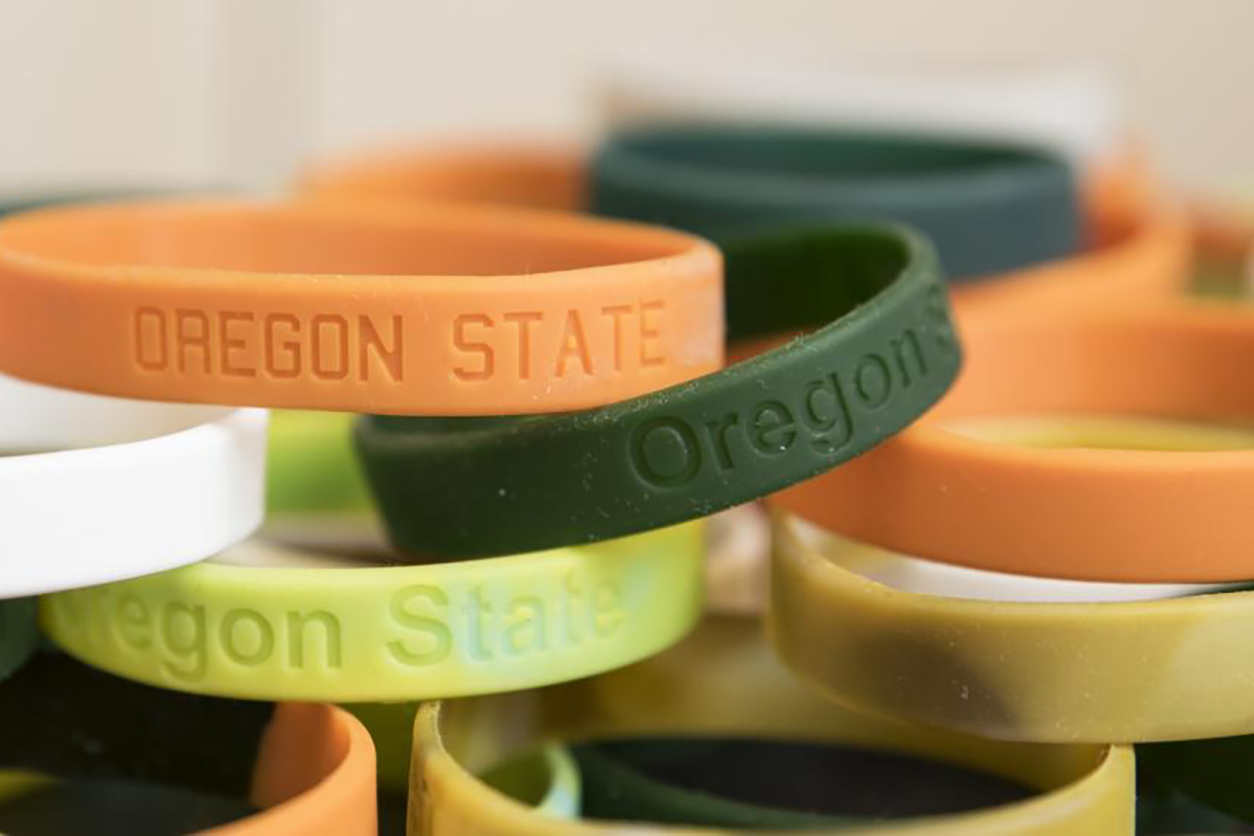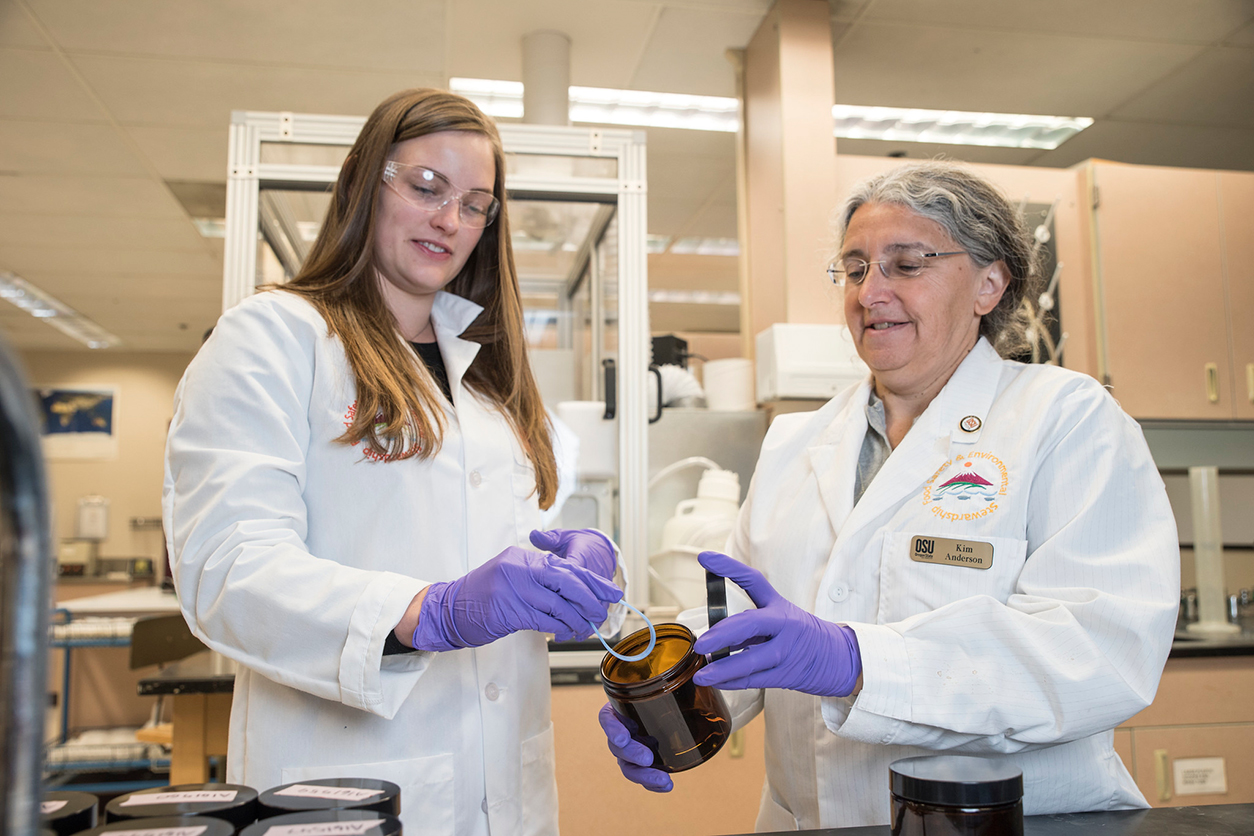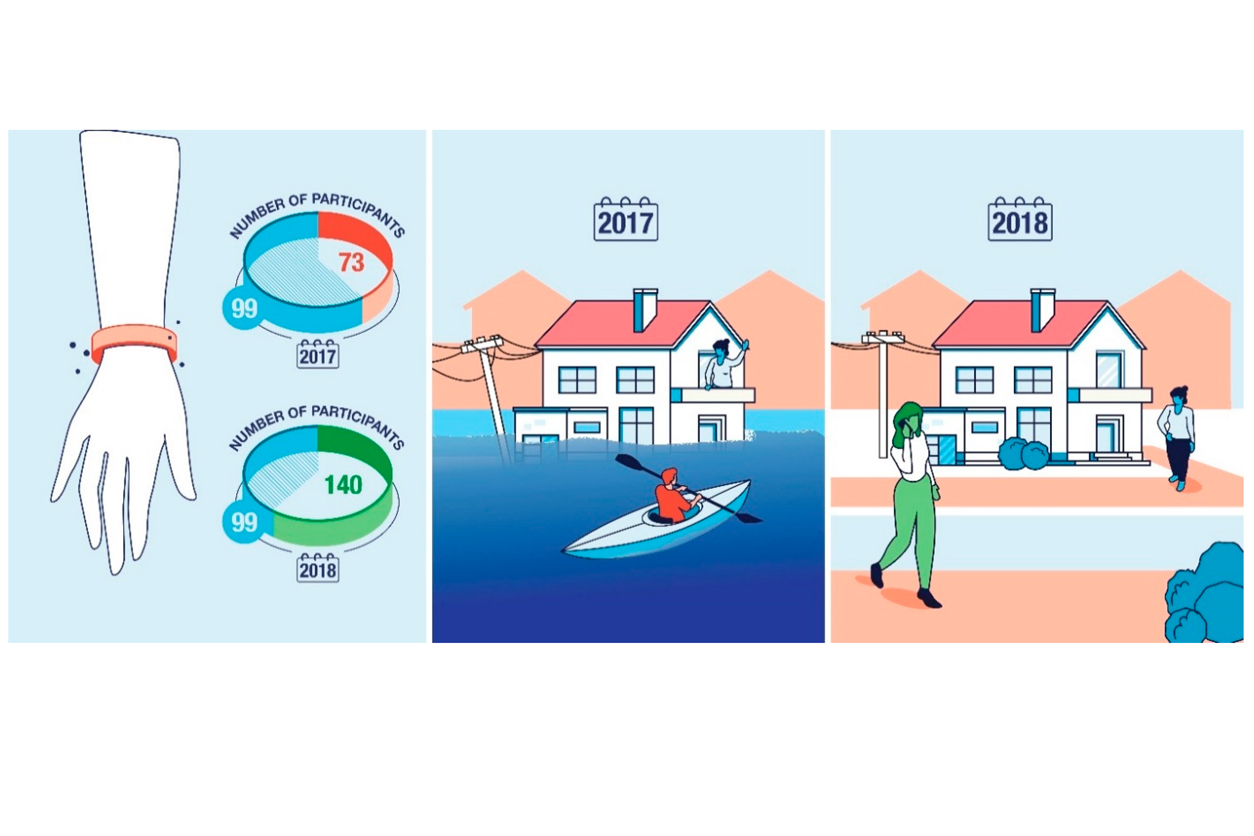With funding from the NIEHS Superfund Research Program (SRP) and other NIEHS programs, researchers at the Oregon State University (OSU) SRP Center developed a simple, non-invasive approach to monitor personal chemical exposures using silicone wristbands. The highly sensitive wristbands can be used to measure exposure to low levels of hundreds of chemicals, offering a unique tool to better understand the complex mixtures people may be exposed to throughout daily life.
“The wristbands have many advantages compared to traditional personal monitoring approaches,” said Kim Anderson, Ph.D., an OSU SRP team lead. “They are small and lightweight, and people can wear them all day as they go about their various activities, commuting, working, cooking, exercising, and sleeping. The wristbands can answer questions about personal exposure to a range of chemicals that we hadn’t been able to address at the individual level in the past.”
The problem
People are exposed to many different chemicals in food, water, air, and products that contact the skin. Some of these exposures may be harmful to human health, but it can be difficult to capture such complex mixtures and understand how they may interact to affect health.
Historically, personal exposure sampling devices have only been capable of detecting a small range of targeted compounds or have been large and cumbersome for study participants. More accurate personal exposure data can be obtained from biological samples, such as blood or urine, but such approaches can be invasive for study participants. To gain a better understanding of the exposome — the totality of exposures a person experiences throughout life and how those exposures may lead to disease — scientists must first have better tools to capture the diverse chemical mixtures that make up an individual’s environment.
SRP solutions

Anderson and former SRP trainee and 2012 K.C. Donnelly award winner Steven O’Connell, Ph.D., developed an approach to extract and analyze more than 1,500 chemicals from silicone wristbands, including pesticides, volatile organic contaminants, personal care products, smoke and oil compounds, flame retardants, and more. The tool provides scientists with a simple way to characterize a person’s unique environmental exposures. Knowing this can help scientists better understand how exposure to chemicals in everyday life affects human health.
The team also co-founded MyExposome Inc., a small business dedicated to monitoring individual environmental exposures.
Keeping it simple
Anderson’s early research focused on developing environmental passive sampling tools that better mimicked the amount of pollutants in water that could be taken up by a living organism and potentially pose a risk to human health.
“An SRP colleague expressed a need for similar tools to collect personal exposure data for humans, which was the nexus for building on our environmental passive sampling technology to monitor individual human exposures using silicone wristbands,” Anderson shared.
Silicone mimics the way that skin and other cells in the body absorb chemicals. When a person wears the silicone wristband, organic chemicals from the air, water, and even their skin are absorbed into the band.
When wristbands are sent back to the lab, chemicals are extracted and analyzed using a method Anderson’s lab developed to determine what chemicals are present and how much. Over the years, the team has validated the wristbands against other traditional personal exposure methods, highlighting their benefits.
“The methods used to extract and analyze chemical compounds from the wristbands is easy to learn and uses routinely available lab equipment,” said Anderson. “Coupled with ease of use in the field, these passive samplers are well suited for all different kinds of populations around the world.”
Wristbands capture unique exposures

Since their development, the silicone wristbands have been used in a variety of contexts and with diverse populations. Anderson and team have also collaborated with other SRP- and NIEHS-funded researchers to understand exposures in children and adults across the U.S. and abroad as follows.
- Collaborated with SRP-funded researchers at Dartmouth College to identify exposures among pregnant women in the New Hampshire Birth Cohort Study.
- Measured preschool children’s exposure to flame-retardant chemicals, revealing housing characteristics, cleaning practices, and family context to be significant drivers of exposure levels.
- Collaborated with researchers at the University of California, Berkeley to characterize pesticide exposures among adolescent Latinas.
- Collaborated with researchers at the Duke University SRP Center to characterize personal exposure to organophosphate and brominated flame-retardant chemicals.
- Collaborated with researchers at the University of Kentucky to study the effect of fracking on air quality based on community concerns.
- Modified the wristbands into military-style silicone dog tags to document firefighter exposures to endocrine disrupting chemicals and other harmful chemicals.
- Modified wristbands into pet tags to capture exposure to flame-retardant chemicals in house cats, which can be used as a surrogate for monitoring human exposure to harmful chemicals in the home.
- Detected, for the first time, individual pesticide exposures among agricultural workers in West Africa, where logistical and practical constraints prevent the use of traditional exposure assessments.
- Revealed differences in mixtures exposures and potential sources that varied by location, such as rural versus urban, in four communities in Peru.
- Identified regional differences and common chemical exposure trends in 14 communities across North America, South America, and Africa.
According to Anderson, the wristbands have been instrumental in making important connections between chemical exposures and toxicity, disaster events and exposures, and chemical exposures and health outcomes in populations. The wristbands also helped the research team better engage with study participants, Anderson added.
Responding to community concerns
Anderson noted that most people do not feel connected with, or trusting of, exposure models or other sources of exposure information.
“Folks want something they can hold and feel, and get their exposure data back,” she said. “The wristbands provide that physical connection that they can touch, and it helps build trust as we share results and knowledge.”
For example, the OSU SRP Center team worked with tribal partners to initiate a community-engaged study using wristbands to measure exposures to polycyclic aromatic hydrocarbons (PAHs). PAHs are contaminants produced from burning biomass, or from certain cultural and spiritual practices like burning candles or incense.
Using the wristbands and participants’ recorded diaries on daily activities, the researchers identified differences in PAH exposure among individuals and across seasons. After the team shared results with participants, community members reported feeling more aware about their potential exposure to PAHs from different sources and, in many cases, felt empowered to take steps to reduce their exposure.

The team also collaborated with researchers at the Texas A&M University SRP Center to monitor exposures after Hurricane Harvey.
“As cleanup efforts began, concerns were raised regarding the human health impacts of chemical exposures resulting from the hurricane and subsequent flooding,” Anderson said. “We used wristbands to look at personal exposures right after the hurricane, and again one year later, as a substitute baseline and were able to document that chemical exposures were generally higher following Harvey.”
According to Anderson and the team, silicone wristbands are simple, low-cost, low-maintenance, and non-invasive, making them well suited to a variety of difficult-to-reach populations and during disasters.
They further stressed how engaging communities and incorporating local knowledge into research frameworks can help promote community resilience after disasters, such as oil spills, hurricanes, and wildfires, while increasing environmental health literacy through culturally aware communication.
(This article was adapted from a Public Health Impacts story.)
(Adeline Lopez is a science writer for MDB Inc., a contractor for the NIEHS Division of Extramural Research and Training.)
Source link
factor.niehs.nih.gov
